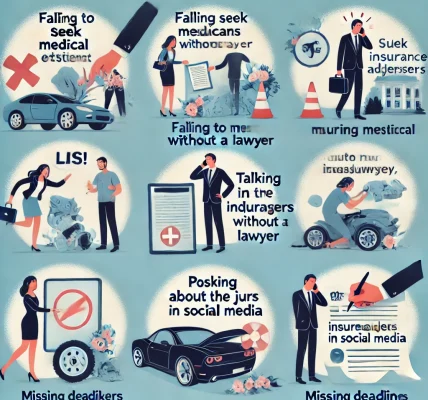When pursuing a personal injury claim, compensation is not limited to medical expenses and lost wages. Victims are also entitled to damages for pain and suffering, which include both physical pain and emotional distress. However, unlike medical bills, pain and suffering are not easily quantifiable. To ensure fair compensation, you must present strong evidence that demonstrates the extent of your suffering.
In this blog, we will cover how to prove pain and suffering in a personal injury claim, the types of evidence needed, and tips to maximize your compensation while staying within legal boundaries.
Understanding Pain and Suffering in Personal Injury Cases
Pain and suffering refer to the physical and emotional distress caused by an injury. It falls into two categories:
1. Physical Pain and Suffering
This includes the actual physical injuries and their impact, such as:
- Chronic pain
- Limited mobility
- Scarring or disfigurement
- Need for ongoing medical treatment
- Long-term or permanent disability
2. Emotional and Mental Pain and Suffering
In addition to physical pain, injuries can lead to psychological struggles, such as:
- Anxiety and depression
- Post-Traumatic Stress Disorder (PTSD)
- Insomnia and sleep disturbances
- Emotional distress due to lifestyle changes
- Loss of enjoyment of life
Since these damages do not have a direct monetary value, proving them requires strategic documentation and legal expertise.
How to Prove Pain and Suffering
1. Medical Records and Doctor’s Reports
Medical documentation is one of the strongest pieces of evidence. Your records should include:
- Diagnosis and treatment history
- Prescriptions for pain relief
- Physical therapy and rehabilitation records
- Medical expert opinions on long-term effects
2. Personal Injury Journal
Maintaining a daily journal is a powerful way to document the impact of your injury. Include:
- Pain levels and symptoms
- Daily limitations (difficulty walking, lifting, working, etc.)
- Emotional struggles (depression, anxiety, frustration)
- Missed activities due to pain
3. Testimonies from Family and Friends
People close to you can provide statements about the changes in your life. These testimonies may include:
- How your personality or mood has changed since the injury
- Struggles with daily tasks and mobility
- Impact on relationships and social life
4. Expert Witness Testimonies
In some cases, expert witnesses can strengthen your claim. These may include:
- Medical professionals who explain the severity of your condition.
- Psychologists or therapists who assess emotional distress.
- Economists or vocational experts who estimate long-term financial losses.
5. Photographs and Videos
Visual evidence can be compelling in proving pain and suffering. Consider including:
- Photos of your injuries at different stages of healing
- Videos showing difficulty in movement or daily tasks
- Before-and-after comparisons of your lifestyle
6. Employment and Work Records
If your injury has affected your ability to work, use employment records to support your claim. These may include:
- Doctor’s notes recommending work restrictions
- Lost wages and reduced earning capacity reports
- Statements from employers about job performance changes
7. Mental Health Records
If you have sought therapy or counseling due to your injury, these records can provide evidence of emotional distress.
Methods of Calculating Pain and Suffering Compensation
There are two main methods used to determine pain and suffering damages:
1. Multiplier Method
This method involves multiplying your actual economic damages (medical bills, lost wages) by a number between 1.5 and 5, depending on the severity of your pain and suffering.
- Mild injuries (sprains, minor fractures) – Multiplier: 1.5 to 2
- Moderate injuries (surgery required, long-term pain) – Multiplier: 2 to 3
- Severe injuries (disability, permanent impairment) – Multiplier: 4 to 5
2. Per Diem Method
This method assigns a daily dollar value to your pain and suffering, multiplied by the number of days you experience pain until full recovery.
- Example: If you assign $200 per day and suffer for 180 days, your pain and suffering damages would be $36,000.
Common Challenges in Proving Pain and Suffering
1. Lack of Objective Proof
Unlike medical bills, pain and suffering do not have clear documentation. This makes it essential to maintain strong records and testimonies.
2. Insurance Company Disputes
Insurance adjusters often downplay pain and suffering claims to reduce payouts. They may argue that:
- Your injuries are not as severe as claimed.
- Pre-existing conditions caused your pain.
- There is insufficient evidence to justify the requested compensation.
3. Inconsistent Statements
Any inconsistencies in your medical records, personal journal, or witness testimonies can weaken your case. Always be truthful and consistent when documenting pain and suffering.
Tips to Strengthen Your Pain and Suffering Claim
✅ Seek medical attention immediately – Delayed treatment can weaken your claim.
✅ Follow your doctor’s recommendations – Ignoring medical advice can be used against you.
✅ Keep thorough documentation – The more evidence you have, the stronger your claim.
✅ Work with a personal injury lawyer – A legal expert can negotiate with insurance companies and ensure fair compensation.
Final Thoughts
Proving pain and suffering in a personal injury claim requires strong documentation, credible testimonies, and expert guidance. Since insurance companies often resist paying these damages, having a strategic approach is essential to maximizing your compensation.
If you or a loved one is pursuing a personal injury claim, consult with an experienced attorney to build a compelling case. With the right evidence, you can secure the compensation you deserve for your physical and emotional suffering.




